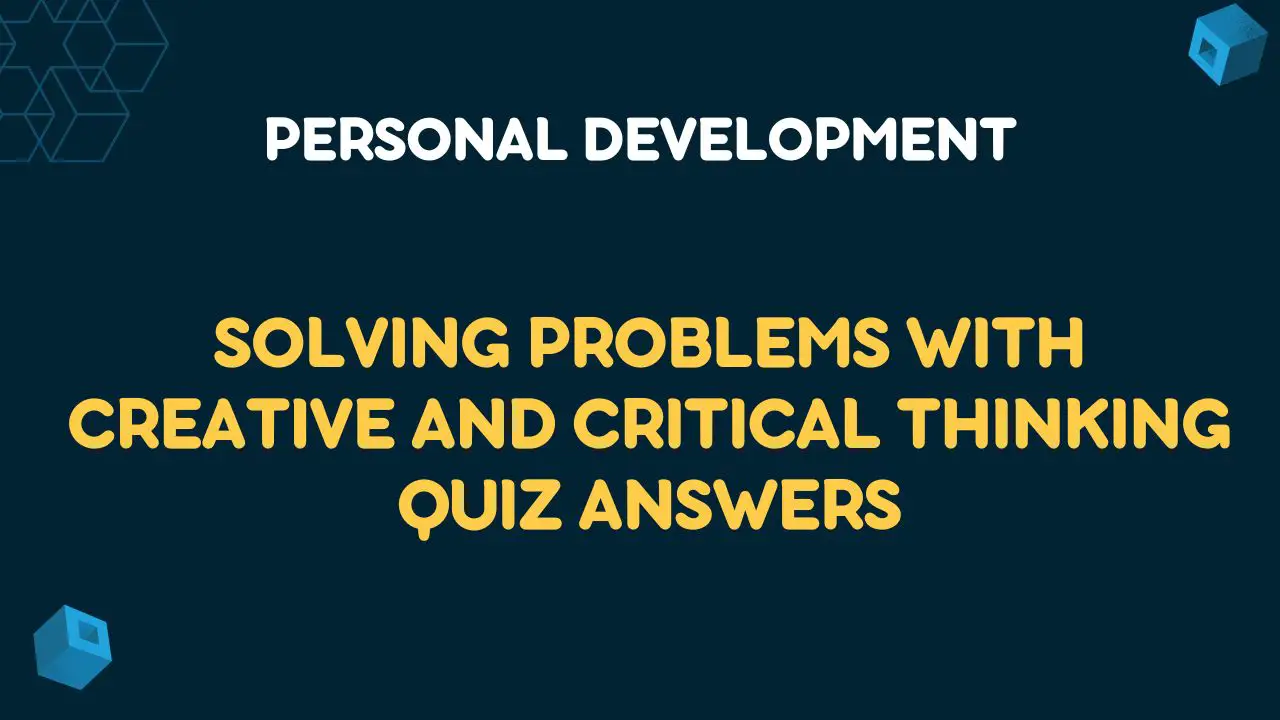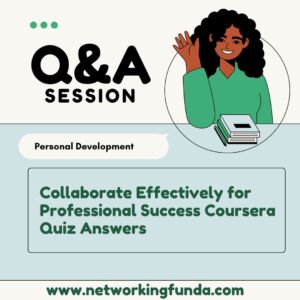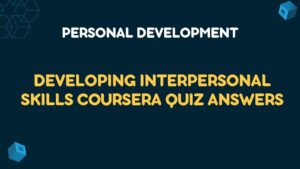Table of Contents
Get All Weeks Solving Problems with Creative and Critical Thinking Quiz Answers
Week 1: Solving Problems with Creative and Critical Thinking Quiz Answers
Quiz 1: Practice Quiz: What do you think?
Q1. Recall the components of the problem statement that you reviewed earlier. Then select the option that you think would be an appropriate problem statement for Georgia.
Which option could be Georgia’s problem statement?
ViewQuiz 2: Practice Quiz: What do you think?
Q1. Which option best describes “The 5 Whys” questioning technique?
- Ask five people involved in the problem why they think it occurred.
- Ask the following:
- Why the problem occurred.
- Why it happened now.
- Why it must be solved.
- Why others haven’t solved it already.
- Why you are involved?
Quiz 3: Practice Quiz: The “5 Whys” for Georgia
Q1. First Why: Why can’t Georgia’s team process 200 expense claims by 31 December?
ViewQ2. Second Why: Why are there fewer people than needed to process the claims?
ViewQ3. Third Why: Why did the unplanned leave affect the work?
ViewQ4. Fourth Why: Why was there no backup plan?
ViewQ5. Fifth Why: Why is the team no longer confident of completing the work?
ViewQuiz 4: Practice Quiz: Which type of solution will work for Georgia?
Q1. Which type of solution will work for Georgia? Select the options that you think will be appropriate.
Select all that apply.
View2. Interim solution
3. Contingent solution
4. Preventing solution
Quiz 5: Practice Quiz: Who should choose the solution in each case?
Q1. If time is of essence, who should choose the solution?
ViewQ2. If quality is critical, who should choose the solution?
ViewQ3. If buy-in is important, who should choose the solution?
ViewQuiz 6: Practice Quiz: Who should choose a solution to Georgia’s problem?
Q1. What do you think? Who should choose the solution to Georgia’s problem?
ViewQuiz 7: Practice Quiz: Using the Ease and Effectiveness Matrix
Q1. View the Ease and Effective Matrix below to assign the given solutions to the specific quadrant.
Solution 1: Begin the first workshop with five participants to start the skill-building process. Assign the solution to the specific quadrant
ViewQ2. Solution 2: Reschedule the workshop to a later date when there are a minimum of nine participants.
ViewQ3. Solution 3: Identify colleagues to assist interested participants with their work so they can enroll in the workshop.
ViewQ4. Solution 4: Create a plan to manage the workload and timelines of projects, to allow those who canceled their registrations to enroll.
ViewQuiz 8: Practice Quiz: Let’s use the Ease and effectiveness matrix for Georgia’s problem
Q1. View the Ease and Effective Matrix below to assign the given solutions to the specific quadrant.
Solution 1: Get resources from other teams to help out.
ViewQ2. Solution 2: Finish as much as possible with the given resources.
ViewQ3. Solution 3: Allow the person caring for her child to work from home on a part-time basis.
ViewQ4. Solution 4: Ask the three people in the team to work more hours by working late and over the weekends and holidays.
ViewQuiz 9: Practice Quiz: What do you think success will look like?
Q1. What do you think is the first part of implementing a solution?
ViewQuiz 10: Practice Quiz: What do you think?
Q1. The first thing you should do is establish the success criteria. In Georgia’s scenario, what would constitute success?
Select all that apply.
View2. She adds a backup in all her team’s plans.
3. Her team accurately completes the work.
Q2. Once you’ve established the success criteria, you should decide what to measure. What aspects should you measure to test how successful your solution is to Georgia’s problem?
Select all that apply.
View2. How accurately her team does the work.
Q3. And lastly, after deciding what to measure, you should determine how you will measure it. How will you measure if the solution to Georgia’s problem meets her goal successfully?
Select all that apply.
View2. Count the number of inaccurate expense claims processed by the end of the day on 31 December.
3. Count the number of expense claims processed on each work day of the month.
4. Count the number of extra hours the team worked.
Quiz 11: Practice Quiz: Solving Problems with Critical and Creative Thinking
Q1. Ashlee has been working as the sole tax accountant on her team for five years. Recently, there’s been a sudden increase in her workload, and this is expected to last. John, another specialist in tax accounting, has just been hired to help.
John and Ashlee often need to collaborate. However, soon Ashlee realizes that this is going to be tough because they have different working styles. John tends to wait until the last minute to get his work done. Ashlee, on the other hand, is methodical.
Ashlee feels that she now has to worry about both his work and her own. While working on joint projects, she is not happy to wait until an hour or so before a deadline when they are forced to collaborate.
Since John is new to the department, he is not comfortable with the conflict. Their supervisor, Anna, feels that the conflict is affecting the quality of their work. Which technique should Anna use to resolve the problem?
ViewQ2. Zach is a sales lead with the Cloud Solutions Sales Team. He, along with his team, is taking part in a quarterly sales challenge. Seven different business units are contending for the champion’s trophy. The team with the highest revenue at the end of the quarter will be declared the winner.
Zach and his team need to use their time and effort efficiently in order to get the best returns from the existing clients and win the challenge.
Listed below is an existing client that Zach deals with. Read the descriptions carefully and help Zach categorize the client and draw up a winning strategy with the help of the Ease and effectiveness matrix.
View the Ease and Effective Matrix below to assign the given solution to the specific quadrant
Client D is one of the team’s first clients. Deals with this client were profitable initially but the returns have diminished with time.
ViewQuiz 12: Graded Quiz: Solving Problems with Critical and Creative Thinking
Some questions may have more than one correct option. Partial credit will be awarded for questions with multiple correct answers.
Q1. Tushar has been a sales manager for almost three years. He is known for his dedication and hard work. He has always been able to meet his sales targets. Last week, Kiran, Tushar’s manager, got a complaint from one of the reps in Tushar’s team. Rehan has been reporting to Tushar for more than a year.
Rehan’s issue is that Tushar tends to get over-involved with their sales techniques, calls out issues in front of the client, and doesn’t take criticism very well. Kiran investigates the issue and concludes that the problem is with Tushar’s leadership style.
Which techniques can Kiran use to resolve the problem?
Select all that apply.
View2.Preventive solution.
Q2. Ainsley is a sales trainer with the ERP optimization team. He is currently responsible for training new hires for up-selling and cross-selling opportunities from the existing portfolio of ERP services. The new hires are responsible for the following:
- Reducing the cost of customer acquisition.
- Enhancing customer retention rates.
- Reducing the sales cycle.
Ainsley has developed a 3-day training program for all the new hires. The program includes situations a sales rep would encounter in the real world while engaging with customers. Ainsley is responsible for tracking the success criteria for the training program. In Ainsley’s scenario, what would constitute success?
Select all that apply.
View2.Selling opportunities increased by more than 5%.
Q3. Brian from the Service Oriented Architecture (SOA) team has planned to run 30 roadshows in Q2. The goal is to bring together the SOA community in person in order to exchange ideas on how to increase the sales volume, help the organization generate leads for its tools and solutions, and drive customer referrals.
Brian also wanted the SOA community to stay connected online before and after the roadshows. So, his team used social media to promote the event as well as to help participants stay connected.
What aspects should Brian measure to test how successful his campaign was?
Select all that apply.
View2.The likeliness of a customer referring Brian’s team to others using NPS.
Q4. Zach is a sales lead with the Cloud Solutions Sales Team. He, along with his team, is taking part in a quarterly sales challenge. Seven different business units are contending for the champion’s trophy. The team with the highest revenue at the end of the quarter will be declared the winner.
Zach and his team need to use their time and effort efficiently in order to get the best returns from the existing clients and win the challenge.
Listed below is an existing client that Zach deals with. Read the descriptions carefully and help Zach categorize the client and draw up a winning strategy with the help of the Ease and effectiveness matrix.
View the Ease and Effective Matrix below to assign the given solutions to the specific quadrant.
Client A is an old client. They have small requirements that can be fulfilled easily. But they have a delayed payment cycle.
ViewQ5. Zach is a sales lead with the Cloud Solutions Sales Team. He, along with his team, is taking part in a quarterly sales challenge. Seven different business units are contending for the champion’s trophy. The team with the highest revenue at the end of the quarter will be declared the winner.
Zach and his team need to use their time and effort efficiently in order to get the best returns from the existing clients and win the challenge.
Listed below is an existing client that Zach deals with. Read the descriptions carefully and help Zach categorize the client and draw up a winning strategy with the help of the Ease and effectiveness matrix.
View the Ease and Effective Matrix below to assign the given solutions to the specific quadrant.
Client B has been a long-term client providing regular business flow but in small deals. Zack has a good rapport with them. They make quarterly payments.
ViewQ6. Zach is a sales lead with the Cloud Solutions Sales Team. He, along with his team, is taking part in a quarterly sales challenge. Seven different business units are contending for the champion’s trophy. The team with the highest revenue at the end of the quarter will be declared the winner.
Zach and his team need to use their time and effort efficiently in order to get the best returns from the existing clients and win the challenge.
Listed below is an existing client that Zach deals with. Read the descriptions carefully and help Zach categorize the client and draw up a winning strategy with the help of the Ease and effectiveness matrix.
View the Ease and Effective Matrix below to assign the given solutions to the specific quadrant.
Client C is a large client. They have a huge requirement. However, they can be billed only after the entire deal is delivered.
ViewConclusion:
In conclusion, the Solving Problems with Creative and Critical Thinking Quiz Answers serve as a valuable assessment tool for individuals seeking to enhance their problem-solving skills. These quiz answers enable learners to gauge their understanding of creative and critical thinking principles and their application in various scenarios. Mastering these skills is crucial in today’s complex and rapidly changing world.
Get All Course Quiz Answers of People and Soft Skills for Professional and Personal Success Specialization >>
Collaborate Effectively for Professional Success Coursera Quiz Answers
Developing Interpersonal Skills Coursera Quiz Answers






can you do people and soft skills assessment?
Sure, We will Notify You once done!